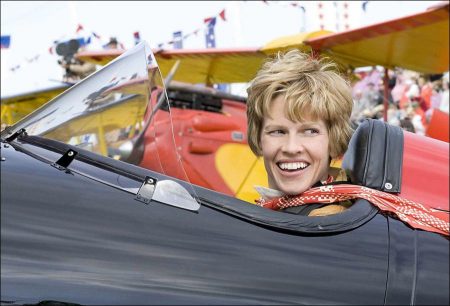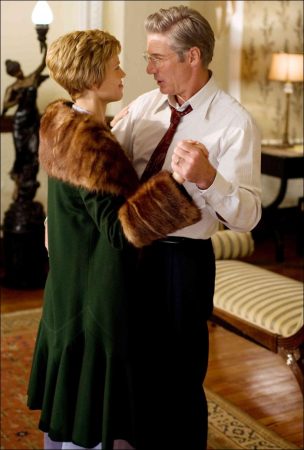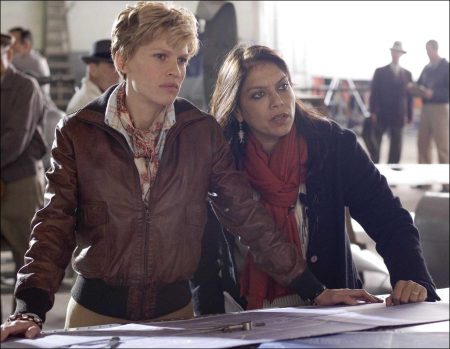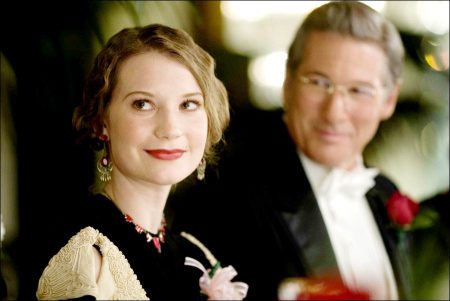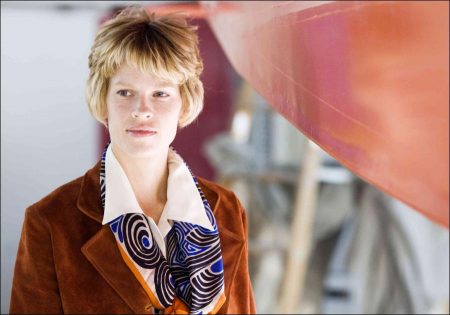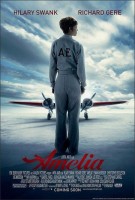All About Amelia
Amelia Movie Trailer. “Amelia is a love story and an action-adventure for the whole family, about a young woman who broke the boundaries and gave a lot to many different people,” says Nair. “I wanted the film to be a living, pulsating portrait of this woman who dared to dream of things that no one had ever done before. Amelia lived life as fully as possible and didn’t put a lid on her emotions or her ambitions. She left behind a legend that I hope will continue to fuel a passion in people to accept no limits.”
The most vivid and adventuresome period in Earhart’s life – from her sudden exposure to global fame in 1928 to her shocking disappearance mid-flight less than ten years later – comes alive on the screen thanks largely to the dogged passion of Avalon Pictures CEO (and the pioneering co-founder of the technology company, Gateway, Inc.) Ted Waitt. An aviation and exploration aficionado in his own right, Waitt had long been fascinated by Amelia’s story.
“Ever since I was a little kid, I was fascinated with Amelia’s disappearance. As I began reading about her, I became even more fascinated with her life than her disappearance,” explains Waitt. “Hers is an incredible story of courage and she was a real pioneer for women as well as aviation.” He continues: “Everyone today knows about Amelia’s disappearance, but very few people understand her life. I thought her tale could be an inspiration, as well as very entertaining. She still ranks as one of the 10 most famous Americans of all time, and people are naturally interested in her – yet not many know her real story.”
Avalon purchased two seminal biographies of Earhart: Susan Butler’s East To The Dawn, which explores little-known aspects of Earhart’s life, including her friendship with First Lady Eleanor Roosevelt, and became the first book to document a secret affair with the aviator and businessman Gene Vidal; and Mary Lovell’s The Sound of Wings, which focuses on Amelia’s intricate relationship with her publicist husband and the intense promotional machinery that surrounded her. “I read all the biographies of Amelia — and Sue Butler’s was incredibly well researched and well written. Mary Lovell’s book was great as well,” comments Waitt.
Waitt also brought in Elgen M. Long, co-author with Marie K. Long of Amelia Earhart: Mystery Solved, as a consultant. Long is an expert on the flight logs that reveal, moment by moment, what happened on Amelia’s final flight from New Guinea en route to Howland Island – as what Long calls “multiple failures of navigation and communication” put her plane in insurmountable peril.
Using these heavily-researched sources as the backbone of their story, two award-winning writers — Academy Award nominee Anna Hamilton Phelan (GORILLAS IN THE MIST) and Academy Award winner Ron Bass (RAIN MAN) – were brought in to forge a screenplay that hinges on authentic, documented history, yet soars beyond the facts to get to the heart of the woman beating. After an intensive examination of her life and times, Phelan and Bass emerged with a portrait of an Amelia so in love with what she saw and felt in the sky that it influenced her every move on earth. Compressing ten years into a couple of hours, Phelan and Bass reveal the many faces of Amelia – businesswoman, daredevil, fashion icon, promoter of women’s rights, wife, lover, die-hard individualist – but most of all as a woman whose palpable humanity is just as moving as her record-setting feats.
What especially struck Mira Nair in reading the screenplay was the idea that Amelia was, in many ways, America’s first true modern celebrity. She was not merely famous but so internationally idolized that her very name and image became a money-making machine. This fame granted her influence that she never imagined and, ultimately, she learned to use it to advance both women’s rights and the age of aviation.
“No matter how you come at it, Amelia’s story is a fascinating tale of mystery and tragedy,” says Nair. “But what intrigued me about the screenplay for AMELIA is seeing her as the first real American icon that also became a brand name. Here was a woman who loved just one thing – flying – but because that was so revolutionary in her time, she came to stand for all kinds of other things including women’s rights and felt a responsibility to be something more to people. Amelia tried to reconcile what she needed to do for money and society against what she felt she had to do to be herself. That’s a game that modern women are still playing.”
The director of such culturally and emotionally rich films as SALAAM BOMBAY!, MONSOON WEDDING, VANITY FAIR and THE NAMESAKE, Nair was born in India and lived in Africa before building her distinctive Hollywood career as one of a handful of woman directors at the forefront of cinema today. Nair fell in love with the forward-thinking American pilot and her fearless vision of life as she read the AMELIA screenplay. Although Nair grew up in an utterly different time and place, she instantly related to Amelia’s strength, optimism and hunger to get things done — on a deeply personal level. “I was born in a small town in India,” the director notes, “and Amelia was from a small-town in Kansas. I felt a great sense of affinity for her dreams to experience the bigger world around her. Those were my dreams, too.”
The screenplay spurred Nair to dive into her own research, screening hours of newsreels and documentaries, reading Amelia’s diaries and documentation of her life collected over the years. “The more I learned about her, the more I was struck by the kind of sweet humility Amelia maintained through it all,” she says. “I think humility and passion make such a lovely combination and is so rarely seen. That really interested me as a filmmaker.”
Finally, Nair was attracted, like Amelia herself, to exploring the lure of flight in the thrilling early days of aviation – when human beings first began to attain a vast freedom over the landscape that only birds previously had known. “I saw in Amelia’s tale someone who is ecstatic in the sky, but also very earth bound,” comments Nair. “She loved nature, and believed in its power, so it’s especially moving that, ultimately, it was the ocean or the skies that swallowed her.”
The screenplay also introduced Nair to the two dashing, fascinating men who grew closest to Amelia: her savvy business partner and eventual husband, George Putnam; and the accomplished pilot and pioneer of the American airline industry, Gene Vidal.
Nair found herself compelled by both men. “George was the first person in this country to create what is now known as public relations. He was also an adventurer in his own right, but he knew he didn’t have what it takes to be an Amelia Earhart or Charles Lindbergh, so he threw his support behind Amelia in his own way, financing her trips with sponsorships and publicity events. Yes, it was Putnam who packaged Amelia, but he was the one who allowed her to explore her passion by finding a way to make money out of it,” she notes.
“Gene was also a huge force in Amelia’s life because they were both very much the public faces of American aviation,” Nair continues. “I think they were deeply attracted to each other, but Gene was the one person who told Amelia the blunt truth, who told her that her adventures were getting reckless, and I think she felt that hampered her dreams. There was both love and conflict driving the three of them.”
Amelia’s Spirit: Hilary Swank
Amelia Earhart became a larger-than-life celebrity not only because of what she did – although her record-breaking flights in an age when flying over oceans certainly grabbed international headlines — but because of who she was. It was her spunk, smarts, can-do optimism, coolness under pressure and unflagging tenacity that defined a vivid new picture of the American woman, indeed of a nation emerging from the Great Depression. Tall and slim with short, windswept hair, the very image of her became synonymous with the soaring ideals of adventure, belief and accomplishment, all accompanied by sweetness and joie de vivre.
It went without saying that any actress willing to take on the role of Amelia would have to bring all of these qualities to the table – and one woman seemed, from the get-go, to be a dead-on match with the fearless, freedom-loving vagabond of the air: Hilary Swank. Having garnered two Academy Awards for transformative roles in BOYS DON’T CRY and MILLION DOLLAR BABY, Swank is no stranger at going to great depths for her roles. But she also possessed something more than just the technical skills and physical attributes to play Earhart. “What’s most extraordinary about Hilary is that she masters all the outward stuff, but then she does something more and communicates the inner workings of Amelia – her humility, her self-effacing goofiness, her sort of unexpected girlishness,” states Nair. “Hilary is a spiritual actor -she really acts from within – and she took great joy in finding Amelia in every way, spending close to a month just getting the look right. The hair, the walk, and especially the speech – her performance was very particular and very deeply Amelia.”
Swank also stunned the director with her talent for flying – and daring deeds. “Hilary is an intuitive daredevil,” observes Nair. “She loves the roller-coaster of life. She would happily jump out in a parachute and come down just like Amelia, with legs swinging wildly!”
For Swank, the role was irresistible. “Amelia was such a trailblazer and I think we have Amelia to thank for girls today feeling like it’s OK to follow a dream,” she says. “She had a quality that I admire: the drive to follow her heart, no matter what, even in a man’s world. What I think the movie shows is that she lived life on her own terms, she believed in having fun and doing what you love and also in helping other people, and she accomplished a lot because of all of that.”
Yet, Swank also knew the role was a risk. “There’s not a lot of liberty you can take with a character like Amelia, because she is such an icon and we have seen so many images of her that they are almost burned into our psyches,” she admits. “I think the challenge for me was to just fully commit to what I believed she was like.”
Part of that commitment meant taking to the skies, and as Swank began flying lessons, she had an eye-opening, personal insight into what drew Amelia towards the heavens. “I realized that she loved flying because she loved feeling free of the constraints she felt on the ground,” the actress muses. “I think she also loved being able to see the world – and you have to understand in those days very few people had that chance – and experiencing new cultures. Most of all, she was driven by the promise of always trying something new. That’s why she was always going after a new record or heading to a new place, and that’s something I could relate to.”
She soon discovered how much Amelia has meant to today’s thousands of women pilots. “Almost every female pilot I met said Amelia was an inspiration to her,” Swank offers. “Amelia would have loved that and she would have really loved to see that women are now flying commercial planes across the Atlantic.”
Swank was also moved by the central romance of AMELIA – the relationship between Earhart and her husband, the public relations vanguard, George P. Putnam, who kept Amelia’s flights financed via a constant spate of public appearances, advertisements and sponsorships. “I think they have a beautiful love story because George really did everything he could to see Amelia’s dreams through,” she explains. “I think she understood that this was a part of her job, a part of being able to fly.”
She also admired Amelia’s brutal honesty with George. “He asked her to marry him many times and she always told him that she didn’t want to be held to the conventional restraints of a marriage, which was so ahead of its time,” Swank says. “But at the same time, she also expressed a great deal of love for him.”
Working with Richard Gere in the role brought all the tenderness and conflict of their relationship to the fore. “Richard is an old soul who walks around with his heart on his sleeve, and I think those are also the characteristics of George Putnam,” she observes.
Once Amelia and George did marry, biographers believe that Earhart carried on an affair with the aviator Gene Vidal, who would, with Amelia’s support, soon join the Roosevelt administration as head of the brand new Bureau of Air Commerce. Swank says it was easy to understand the attraction between them. “With Gene, she had this shared passion, they both loved to fly and both wanted to advance the business of aviation in America and they saw the world in a similar way because of that,” she explains. “Ewan brought a richness to the character that made him the complete opposite of Richard. Both men were an embodiment of what Amelia wanted in life, and yet they were so different.”
For Swank, the international production filled with flights both real and simulated was a nonstop adventure, but throughout, she says she had another heroine, aside from Amelia, keeping her grounded: Mira Nair. “I think Mira is a kindred spirit of Amelia,” Swank concludes. “She’s a force of nature, a very strong woman who doesn’t apologize for being strong. It’s wonderful to see a woman command respect the way she does and have such a clear vision. It’s a breath of fresh air.”
Amelia’s Loves
The whole world fell in love with Amelia Earhart, but her relationships with two men in particular would help to further her career and drive her fame. The first was the man who helped to forge her public image and would become her husband: George Palmer Putnam. Born to the founder of the publishing house G.P Putnam’s Sons, George led his own life of adventure before he met Amelia. He studied at Harvard, led National Geographic expeditions, served as the Mayor of Bend, Oregon and managed several newspapers, then took over the family publishing business with a bang: releasing Charles Lindbergh’s autobiography We. It was in 1928, while looking for a woman to become the first to fly across the Atlantic, that George met a then unknown Amelia Earhart. They were married in 1931, by which time she was already one of the most famous people in the world.
Golden Globe winner Richard Gere found Putnam a fascinating historical personality. “He was one of those controversial characters a lot of people disliked, but Amelia didn’t. She obviously loved this guy and that interested me,” he explains. “I wanted to know more about their bond. What did they see in each other in their private lives that maybe nobody else could see? What made them fit together? They were two very self-directed, strong, focused people and one of the quirks of fate is that they happened to run into each other at just the right time.”
Gere was also intrigued by the way Putnam seemed to intuit how Earhart’s personality could take on a life of its own – becoming the tool that would finance her record-setting flights and keep the public always wanting to see and know more about her. “There was a kind of Barnum & Bailey aspect to him, the way he plucked Amelia from obscurity and came up with this whole `Lady Lindy’ image,” he says. “There were other women flyers who may have been better or more beautiful, but I think what George saw in Amelia was that she was so genuine in her love of flying and so approachable, that she would be embraced as a role model for all women.”
Mira Nair says that she saw a new quality emerging in Gere in the role of George. “Of course Richard always has great charisma,” she observes, “but I think he also now exudes a real sense of calm and authority which was a great match for this role. He gave a very meditative type of performance – and there was a palpable chemistry that emerged between him and Hilary.”
Once on the set, the highlight for Gere became working with Swank. “She’s so perfect for this part because her instincts are the same as Amelia’s – it’s just natural for her to take risks and avoid clichés. She also has that basic trustworthiness, that way of saying `I might be a little goofy, but that’s me.’”
That helped in recreating the unique link that Amelia and George shared, no matter how unconventional their marriage. Says Gere: “The scenes between us have a subtle, emotional vibration. These were two people who were trying to be the best they could but still sometimes hurt each other.” Some of that hurt emerged from Amelia’s free spirit, which she warned George about openly before marrying him. Nevertheless, her close relationship with the pilot Gene Vidal, with whom she would found Northeastern Airlines, further complicated their marriage.
Vidal was another intriguing early 20th century character. Now best known as the father of famed writer Gore Vidal, Gene taught Aeronautics at West Point, founded three American airlines and served as the Director of the Bureau of Air Commerce from 1933-1937. To play him, Nair chose Ewan McGregor, the Scottish actor known for a diversity of roles, ranging from the gritty indie hit TRAINSPOTTING to Obi Wan-Kanobi in the STAR WARS prequels. “Ewan is so dashing,” says Nair. “He exudes that kind of cool Cary Grant grace and formality that you don’t see anymore, yet at the same he’s very hip and modern, which is what we wanted for Gene Vidal.”
McGregor says the first thing that drew him to AMELIA was the chance to act with Swank. “I’ve wanted to work with her since BOY’S DON’T CRY,” he says. “Her work is passionate, detailed and committed. I’ve always liked working that way myself, so I knew it would be great fun.”
But once he took on the role of Vidal, he also became compelled by the challenges of the character. “It was an interesting task to try to create this relationship on screen that is quite ambiguous. It’s understood that Gene and Amelia had some kind of a love affair, but the details are unknown,” he explains. “In the film, it becomes a kind of unspoken love triangle, where nobody is quite talking about what’s going on, which I found really fascinating.”
As much as he was anticipating working with Swank, McGregor says he still was taken aback by her. “It seemed that Amelia was alive and well and living inside Hilary Swank,” he notes. “The way Hilary plays her, you get a sense of how extraordinary she was. I realize that my daughters are living a life of freedom and opportunity because of women like Amelia.”
Rounding out the main cast is another man who figured prominently in Amelia’s story: the talented aerial navigator, Fred Noonan, who would disappear with Amelia over the Western Pacific. Having made his reputation navigating the pioneering “Manila Clipper” transatlantic route for Pan American Airlines, Noonan had impeccable credentials, yet was also known as a heavy drinker, a contradiction brought to light in the performance by the English actor Christopher Eccleston.
“I’ve adored Chris Eccleston since his first roles in JUDE and SHALLOW GRAVE and I think he’s one of the most extraordinary actors,” says Nair. “He looks blindingly like Fred Noonan and has sex appeal, but most of all Chris just has an absolute natural ease with the camera and with himself. He’s very earthy and independent, yet without ego, as Fred was. Fred had all sides to him: he was both a hard drinker and the best navigator in the world – and Chris nailed that contrast. I think the scenes with Fred and Amelia at the end of the film are truly moving and memorable.”
Amelia: Timeline
July 24, 1897 – Amelia Mary Earhart is born in Atchison, Kansas. Her father is a lawyer and inventor, but also an alcoholic. Her mother is the first woman to summit Pike’s Peak in Colorado.
January 3, 1921 – Just a few months after American women win the right to vote, Amelia starts taking flying lessons from woman pilot Neta Snook.
December 15, 1921 – Amelia receives her flying license.
October 22, 1922 – Amelia breaks the women’s altitude record, rising to 14,000 feet.
June 17-18, 1928 – Amelia becomes the first woman to fly across the Atlantic (as a passenger) in a Fokker F7 piloted by Wilmer Stultz. Upon her return to New York, she is honored with a parade, handed the key to the city and invited to meet the President of the United States.
October, 1928 – Amelia begins a series of lecture tours organized by George Putnam to promote her first book: 20 Hrs. 40 Min, which establishes her full-fledged celebrity.
August 1929 – Amelia places third in the First Women’s Air Derby, aka the Powder Puff Derby, in her brand new Lockheed Vega. As America falls into the tough times of the Great Depression, Amelia becomes a symbol of can-do optimism and American spirit.
November, 1929 – Amelia helps to organize The Ninety-Nines, the first women pilots’ organization.
July 5, 1930 – Amelia sets the women’s world speed record of 181.18mph over a 3K course.
February 7, 1931 – George Putnam and Amelia Earhart are married in Connecticut.
April 8, 1931 – Amelia sets the woman’s autogiro altitude record of 18,415 feet.
May 20-21, 1932 – Amelia becomes the first woman and second person to fly solo across the Atlantic. She receives the National Geographic Society’s gold medal from President Hoover and the Distinguished Flying Cross from Congress. She writes her second book, The Fun of It, about her journey.
August 24-25, 1932 – Amelia sets the women’s record for fastest non-stop transcontinental flight.
April, 1933 – Amelia is invited to dinner at the White House with Franklin and Eleanor Roosevelt. – and famously takes the First Lady on her first-ever night flight, sparking a lasting friendship.
January, 1934 – Amelia turns to the Pacific Ocean and becomes the first pilot to fly solo from Hawaii to California. Soon after, she debuts her own brand-name fashion line at Macy’s.
January 11, 1935 – Amelia pioneers the first solo flight across the Pacific Ocean, between Honolulu and Oakland, and uses the first civilian plane equipped with a two-way radio.
April 19 – 20, 1935 – Amelia is the 1st person to fly solo from Los Angeles to Mexico City.
June 1, 1937 – Amelia and Fred Noonan take off from Miami, Florida on an around-the-world flight. After 22,000 miles of flying, Earhart and Noonan are last seen in Lae, New Guinea. On July 2nd, en route to tiny Howland Island for refueling, the U.S. Coast Guard cutter “Itasca” loses contact with Earhart and she is not heard from again. President Roosevelt orders a massive search, which is called off on July 18, 1937. Two years later she is declared legally dead.
Production notes provided by 20th Century Fox.
Amelia (2009)
Directed by: Mira Nair
Starring by: Hilary Swank, Richard Gere, Ewan McGregor, Christopher Eccleston, Mia Wasikowska, Aaron Abrams, Dylan Roberts, Cherry Jones, Ryann Shane, Elizabeth Shepherd, Richard Donat
Screenplay by: Ronald Bass
Production Design by: Stephanie Carroll
Cinematography by: Stuart Dryburgh
Film Editing by: Allyson C. Johnson, Lee Percy
Costume Design by: Kasia Walicka-Maimone
Set Decoration by: Darlene Lewis, Gordon Sim
Art Direction by: Nigel Churcher
Music by: Gabriel Yared
MPAA Rating: PG for some sensuality, language, thematic elements and smoking.
Distributed by: 20th Century Fox
Release Date: October 23, 2009
Views: 299
